Mechanical Properties Of Fluids MCQs
NEET Physics For Mechanical Properties Of Fluids Multiple Choice Questions
Question 1. A barometer is constructed using a liquid (density = 760 kg/m3). What would be the height of a liquid column, when a mercury barometer reads 76 cm? (Density of mercury = 13600 kg/m3)
- 1.36 m
- 13.6 m
- 136 m
- 0.76 m
Answer: 2. 13.6 m
Given
A barometer is constructed using a liquid (density = 760 kg/m3). What would be the height of a liquid column
From the given question,
Density of liquid, F1 = 760 kg/m3
Density of mercury, fm = 13600 kg/m3
Height of liquid column in mercury barometer hv = 760 cm = 0.76 m
If the height of the liquid in the liquid column is h1 then
⇒ \(\rho_{\text {liquid }} =\rho_{\text {mercury }}\)
⇒ \(h_l \rho_l g =h_m \rho_m g\)
⇒ \(h_l =\frac{h_m \rho_m}{\rho_l}\)
=\(\frac{0.76 \times 13600}{760}\)
=13.6 m.
Question 2. In a w-tube, as shown in the figure, water, and oil are on the left side and right side of the tube respectively. The heights from the bottom for water and oil columns are 15 cm and 20 cm respectively. The density of the oil is [take \(rho\)water= 1000 kg/m3] :
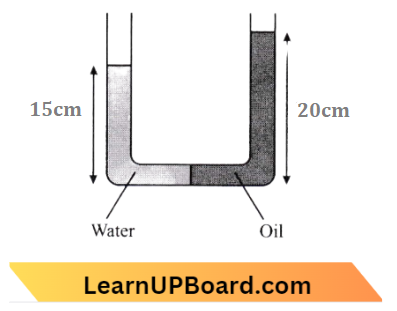
- 1200 kg/m3
- 750 kg/m3
- 1000 kg/m3
- 1333 kg/m3
Answer: 2. 750 kg/m3
According to Pascal’s law, “Pressure applied to an enclosed fluid is transmitted undiminished to every point of the fluid and the walls of the containing vessel.”
Read and Learn More NEET Physics MCQs
In the given situation as shown in the figure given below,
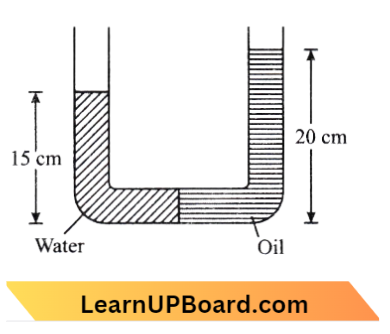
Pressure due to water column of height 15 cm = Pressure due to oil column of height 20 cm
⇒ \(h_w \rho_w g =h_0 \rho_0 g\)
⇒ \(15 \rho_w =20 \rho_0\)
⇒ \(\rho_0 =\frac{15}{20} \rho_w\)
⇒ \(\rho_0 =\frac{15}{20} \times 1000\)
⇒ \(\left(\text { Given } \rho_w=1000 \mathrm{~kg} \mathrm{~m}^{-3}\right)\)
=\(750 \mathrm{kgm}^{-3}\)
Mechanical Properties of Fluids MCQs
Question 3. A U tube with both ends open to the atmosphere is partially filled with water. Oil, which is immiscible with water, is poured into one side until it stands at a distance of 10 mm above the water level on the other side. Meanwhile, the water rises by 65 mm from its original level (see diagram). The density of the oil is:
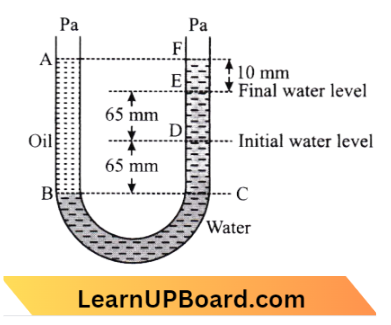
- 650 kg m-3
- 425 kg m-3
- 800 kg m-3
- 928 kg m-3
Answer: 4. 928 kg m-3
Given
A U tube with both ends open to the atmosphere is partially filled with water. Oil, which is immiscible with water, is poured into one side until it stands at a distance of 10 mm above the water level on the other side. Meanwhile, the water rises by 65 mm from its original level (see diagram).
Both the ends of the U-tube are open, so the pressure on both the free surfaces is equal,
⇒ \(P_1 =P_2 \)
⇒ \(h_{\text {oil }} \cdot S_{\text {oil }} \cdot g =h_{\text {water }} \cdot S_{\text {water }} \cdot g \)
⇒ \(\mathrm{~S}_{\text {oil }} =\frac{h_{\text {water }} \cdot \mathrm{S}_{\text {water }}}{\mathrm{h}_{\text {oil }}}\)
∴ \(S_{\text {oil }} =\frac{(65+65)+1000}{(65+65+10)}=928 \mathrm{kgm}^{-3}\)
Question 4. Two non-mixing liquids of densities p and np(n > 1) are put in a container. The height of each liquid is h. A solid cylinder of length l, and density d is put in this container. The cylinder floats with its axis vertical and length \(\rho \mathrm{L}\), (\((\rho<1)\) ) in the denser liquid. The density d is equal to:
- \(\{2+(n+1) \rho\} \rho\)
- \(\{2+(n-1) \rho\} \rho\)
- \(\{1+(n-1) \tilde{\rho}\} \rho\)
- \(\{1+(n+1) \rho\} \rho\)
Answer: 3. \(\{1+(n-1) \tilde{\rho}\} \rho\)
The given figure explains the situation of the question,
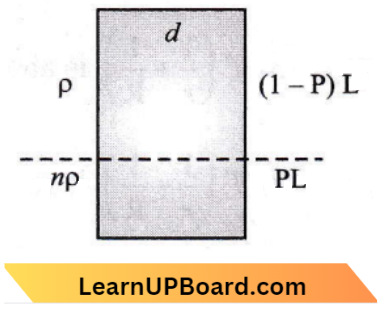
Given
Two non-mixing liquids of densities p and np(n > 1) are put in a container. The height of each liquid is h. A solid cylinder of length l, and density d is put in this container. The cylinder floats with its axis vertical and length \(\rho \mathrm{L}\), (\((\rho<1)\) ) in the denser liquid.
Applying Archimedes principle, we have weight of cylinder=\((\text { upthrust })_1+(\text { upthrust })_2\)
⇒ \(L A d g=(P L) A(n \rho) \mathrm{g}+(1-P) L A \rho g \)
d=\((1-P) \rho+(P n) \rho=[1+(n-1) P] \rho\)
Question 5. The approximate depth of an ocean is 2700 m. The compressibility of water is 45.4 x 10-11 Pa-1 and the density of water is 103 Kg/m3. What fractional compression of water will be obtained at the bottom of the ocean?
- 0.8×10-2
- l.0x 10-2
- 1.2 x 10-2
- 1.4 x 10-2
Answer: 3. 1.2 x 10-2
Depth of the ocean, d=2700 \(\mathrm{~m}\)
Compressibility of water, k=\(45.4 \times 10^{-14} \mathrm{pa}^{-1}\)
Density of water, \(\rho=10^3|g| \mathrm{m}^3\)
The pressure at the bottom of the ocean is,
P = \(\rho g d\)
= \(10^3 \times 10 \times 2700 \)
= \(27 \times 10^6 \mathrm{pa}\)
Fractional compression
= \({ Compressibility } \times { pressure }\)
= \(45.4 \times 10^{-11} \times 27 \times 10^6\)
= \(1.2 \times 10^{-2}\)
MCQs on Mechanical Properties of Fluids for NEET
Question 6. The heart of a man pumps 5 L of blood through the arteries per minute at a pressure of 150 mm of mercury. If the density of mercury. If the density of mercury be 13.6 x 103 kg/m3 and g = 10 m/s2, then the power of heart in watt is:
- 1.70
- 2.35
- 3.0
- 1.50
Answer: 1. 1.70
Given
The heart of a man pumps 5 L of blood through the arteries per minute at a pressure of 150 mm of mercury. If the density of mercury. If the density of mercury be 13.6 x 103 kg/m3 and g = 10 m/s2,
Pressure =150 \(\mathrm{~mm} \text { of } \mathrm{Hg}\)
Pumping rate = \(\frac{d v}{d t}=\frac{5 \times 10^{-3}}{60} \mathrm{~m}^3 / \mathrm{s}\)
Power of heart= \(P. \frac{d v}{d t}=\rho g h \cdot \frac{d v}{d t}\)
= \((13.6 \times 10^3 \mathrm{~g}(\mathrm{~m}^3)(10)\).
⇒ \((0.15) \times \frac{5 \times 10^{-3}}{60} \)
= \(\frac{13.6 \times 5 \times 0.15}{60}=1.70 \text { Watt }\)
Question 7. The cylinder tube of a spray pump has a radius R, one end of which has n fine holes, each of radius r. If the speed of the liquid in the tube is v, the speed of the ejection of the liquid through the holes is:
- \(\frac{v \mathrm{R}^2}{n^2 r^2}\)
- \(\frac{v \mathrm{R}^2}{n r^2}\)
- \(\frac{v \mathrm{R}^2}{n^2 r^2}\)
- \(\frac{v^2 \mathrm{R}}{n r}\)
Answer: 2. \(\frac{v \mathrm{R}^2}{n r^2}\)
Using the equation of continuity, Av = constant
Where, A = area of cylindrical tube
v = velocity of liquid in the tube
Volume in flow rate = Volume outflow rate
⇒ \(\pi R^2 v =n \pi r^2 v^{\prime}\)
∴ \(v^{\prime} =\frac{R^2 E}{n r^2}\)
Question 8. A small hole of area of cross-section 2 mm2 is present near the bottom of a filled open tank of height 2 m. Taking g = 10 m/s2, the rate of flow of water through the open hole would be nearly:
- \(8.9 \times 10^{-6} \mathrm{~m}^3 / \mathrm{s}\)
- \(2.23 \times 10^{-6} \mathrm{~m}^3 / \mathrm{s}\)
- \(6.4 \times 10^{-6} \mathrm{~m}^3 / \mathrm{s}\)
- \(12.6 \times 10^{-6} \mathrm{~m}^3 / \mathrm{s}\)
Answer: 4. \(12.6 \times 10^{-6} \mathrm{~m}^3 / \mathrm{s}\)
Rate of flow of liquid,
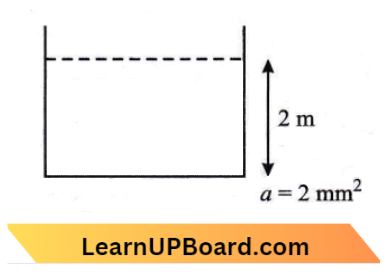
⇒ \(\mathrm{Q}=a u=a \sqrt{2 g h}\)
a=\(2 \mathrm{~mm}^2 \)
=\(2 \times 10^{-6} \mathrm{~m}^2 \times 2 \mathrm{~m} / \mathrm{s}\)
=\(2 \times 2 \times 3.14 \times 10^{-6} \mathrm{~m}^3 / \mathrm{s}\)
=\(12.56 \times 10^{-6} \mathrm{~m}^3 / \mathrm{s}\)
=\(12.6 \times 10^{-6} \mathrm{~m}^3 / \mathrm{s}\)
Mechanical Properties of Fluids Questions NEET
Question 9. A wind with a speed of 40 m/s blows parallel to the roof of a house. The area of the roof is 250 m2. Assuming that the pressure inside the house is atmospheric, the force exerted by the wind on the roof and the direction of the force will be (\(\left(\rho_{\text {air }}=1.2 \mathrm{~kg} / \mathrm{m}^3\right) =\) 1.2 kg/m2):
- 2.4 x 105 N, upwards
- 2.4 x 105 N, downwards
- 4.8 x 105 N, downwards
- 4.8 x 105 N, upwards
Answer: 1. 2.4 x 105 N, upwards
⇒ \(P-\frac{1}{2} \rho v^2\)= constant
Inside the pressure is \(\mathrm{P}_{\mathrm{arm}}\)
The pressure outside is \(\mathrm{P} \)
v is zero inside,
⇒ \(\mathrm{P}-\mathrm{P}_{\mathrm{arm}}=\frac{1}{2} \rho \mathrm{v}^2=\frac{1}{2} \times 1.2 \times 40^2\)=960
Force is F=\(\left(P-P_{\text {arm }}\right) \times \text { Area }=960 \times 250=2.4 \times 10^5 \mathrm{~N}\)upward direction as pressure goes from higher to lower pressure area.
Question 10. A fluid is in streamlined flow across a horizontal pipe of the variable area of cross-section. For this which of the following statements is correct?
- The velocity is maximum at the narrowed part of the pipe and pressure is maximum at the widest part of the pipe.
- Velocity and pressure both are maximum at the narrowest part of the pipe.
- Velocity and pressure both are maximum at the widest part of the pipe.
- The velocity is minimum at the narrowest part of the pipe and the pressure is minimum at the widest part of the pipe.
Answer: 1. The velocity is maximum at the narrowed part of the pipe and pressure is maximum at the widest part of the pipe.
The velocity is maximum at the narrow part of the pipe and pressure is maximum at the widest part of the pipe.
Using the equation of continuity, Av = constant.
And According to the Bernoulli’s theorem,\(P+\frac{1}{2} \rho v^2\) = constant
Mechanical Properties of Fluids Questions NEET
Question 11. A spherical ball is dropped in a long column of a highly viscous liquid. The curve in the graph shown, which represents the speed of the ball (v) as a function of time (t) is:
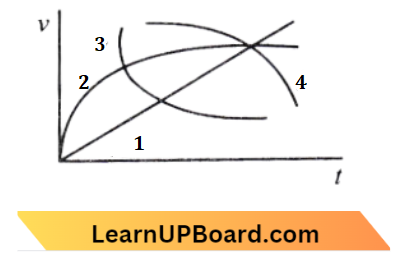
- 2
- 3
- 4
- 1
Answer: 1. 2
1. Viscous force is the force of sliding friction between two solid surfaces in a fluid. Viscosity is frequently referred to as fluid friction because of this. Viscous forces, like other frictional forces, impede the relative motion of nearby fluid layers.
2. When we drop a ball in liquid that is highly viscous and when it falls then initially gravitational force acts. As it goes inside liquid then viscous force increases so its speed will be constant with time after sometimes because gravitational force is balanced by drag or viscous force
3. When gravitational force is balanced by drag force then the acceleration of the particle which can be measured by the slope of the v and t graph initially becomes negative but after some time it becomes zero which means velocity becomes constant with time.
The v -t graph can be shown by
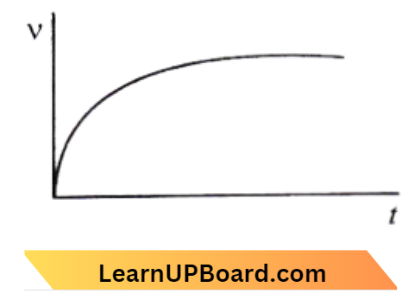
∴ It shows motion as the B part of the graph
Question 12. The velocity of a small ball of mass M and density d, when dropped in a container filled with glycerine becomes constant after some time. If the density of glycerine is \(\frac{d}{2}\), then the viscous force acting on the ball will be:
- \(\frac{\mathrm{Mg}}{2}\)
- \(\mathrm{Mg}\)
- \(\frac{3}{2} \mathrm{Mg}\)
- \(2 \mathrm{Mg}\)
Answer: 1. \(\frac{\mathrm{Mg}}{2}\)
Given
The velocity of a small ball of mass M and density d, when dropped in a container filled with glycerine becomes constant after some time. If the density of glycerine is \(\frac{d}{2}\)
the mass of the ball = M
Density of ball = d
Density of glycerine = d/2
⇒ \(\mathrm{F}_{\mathrm{V}}+\mathrm{F}_{\mathrm{B}} =\mathrm{Mg}\)
⇒ \(\mathrm{F}_{\mathrm{B}} =\frac{4}{3} \pi \mathrm{R}^3 g d g\)
=\(\mathrm{Vg} d g \)
⇒ \(\mathrm{Mg} =\mathrm{V} d g\)
⇒ \(\mathrm{~F}_{\mathrm{V}} =\mathrm{Mg}-\mathrm{F}_{\mathrm{B}}\)
=\(\mathrm{Vg}\left(d-\frac{d}{2}\right)\)
=\(\frac{v g d}{2} \)
∴ \(\mathrm{~F}_{\mathrm{V}} =\frac{\mathrm{Mg}}{2}\)
Class 11 Mechanical Properties of Fluids MCQs
Question 13. Two small spherical metal balls, having equal masses, are made from materials of densities \(\rho_1 \text { and } \rho_2\), \(\left(\rho_1=8 \rho_2\right)\) and have radii of 1 mm and 2 mm, respectively. They are made to fall vertically (from rest) in a viscous medium whose coefficient of viscosity equals t) and whose density is 0.1 \(\rho_2\). The ratio of their terminal velocities would be:
- \(\frac{79}{72}\)
- \(\frac{19}{36}\)
- \(\frac{39}{72}\)
- \(\frac{79}{36}\)
Answer: 4. \(\frac{79}{36}\)
Given
Two small spherical metal balls, having equal masses, are made from materials of densities \(\rho_1 \text { and } \rho_2\), \(\left(\rho_1=8 \rho_2\right)\) and have radii of 1 mm and 2 mm, respectively. They are made to fall vertically (from rest) in a viscous medium whose coefficient of viscosity equals t) and whose density is 0.1 \(\rho_2\).
The terminal velocity of the ball in a viscous fluid is, \(v_T=\frac{2}{9 \eta} r^2 g(\sigma-\rho)\)
Where, \(\eta= coeff\). of viscosity of the medium
r = radius of ball
⇒ \(\sigma\)= density of ball
⇒ \(\rho \)= density of viscous medium
From the formula, \(\mathrm{v}_{\mathrm{T}} \propto r^2(\sigma-\rho)\)
From this formula
⇒ \(\frac{\text { Terminal velocity of } \mathrm{I}^{\mathrm{st}} \text { ball }}{\text { Terminal velocity } \mathrm{II}^{\text {nd }} \text { ball }}=\frac{\mathrm{v}_1}{\mathrm{v}_2}\)
=\(\frac{1^2}{2^2} \frac{\left(8 \rho_2-0.1 \rho_2\right)}{\left(\rho_2-0.1 \rho_2\right)}\)
∴ \(\frac{\mathrm{v}_1}{\mathrm{v}_2}=\frac{1}{4} \times \frac{7.9}{0.9}=\frac{79}{36}\)
Question 14. A small sphere of radius r falls from rest in a viscous liquid. As a result, heat is produced due to viscous force. The rate of production of heat when the sphere attains its terminal velocity is proportional to:
- \(r^5\)
- \(r^2\)
- \(r^3\)
- \(r^4\)
Answer: 1. \(r^5\)
If, F= Viscous force
⇒ \(v_T \)= terminal velocity
F =\(6 \pi r \eta v_T\)
⇒ \(\frac{d \mathrm{Q}}{d t} =6 \pi \eta r v T \times v_T \)
=\(6 \pi \eta r v_T^2\) → Equation 1
We also know that terminal velocity,
⇒ \(v_T=\frac{2}{9} \frac{r^2(\rho-\sigma)}{\eta} g\)
⇒ \( v_T \propto r^2\) → Equation 2
From (1) and (2),
⇒ \(\frac{d \mathrm{Q}}{d t} \propto r .\left(r^2\right)^2 \)
∴ \(\frac{d \mathrm{Q}}{d t} \propto r^5 \)
Class 11 Mechanical Properties of Fluids MCQs
Question 15. If a soap bubble expands, the pressure inside the bubble:
- increases
- remains the same
- is equal to the atmospheric pressure
- decreases
Answer: 4. decreases
As we know the pressure of the soap bubble is written as; \(\mathrm{P}_{\mathrm{i}}-\mathrm{P}_{\mathrm{o}}=\frac{4 T}{r}\) → Equation 1
When the soap bubble expands, the radius of the soap bubble will increase, therefore from equation (1), we see that the change in pressure is inversely proportional to the radius of the soap.
Soap bubble expands, the radius will increase and the inside pressure will decrease
Question 16. A liquid does not wet the solid surface if the angle of contact is:
- equal to 45°
- equal to 60°
- greater than 90°
- zero
Answer: 3. greater than 90°
A liquid does not wet the solid surface if the angle of contact is obtuse i.e., greater than 90°. In this case, cohesive forces will be greater than adhesive forces and so, the liquid does not wet the surfaces of the solid.
Important MCQs on Mechanical Properties of Fluids
Question 17. A capillary tube of radius r is immersed in water and water rises in it to a height h. The mass of water in the capillary tube is 5 g. Another capillary tube of radius 2r is immersed in water. The mass of water that will rise in this tube is:
- 5.0 g
- 10.0 g
- 20.0 g
- 2.5 g
Answer: 4. 2.5 g
Given
A capillary tube of radius r is immersed in water and water rises in it to a height h. The mass of water in the capillary tube is 5 g. Another capillary tube of radius 2r is immersed in water.
The height of water rise in a capillary tube is h =\(\frac{2 \mathrm{~T} \cos \theta}{r \rho g}\)
⇒ \(h \propto \frac{1}{r} \)
⇒ \(\frac{h_1}{h_2} =\frac{r_2}{r_1}=\frac{2 r}{r}\)=2
m =\({ A.h. } \rho\)
⇒ \(\frac{m_2}{m_1} =\frac{A h_2 \rho}{A h_1 \rho}=\frac{h_2}{h_1}=\frac{1}{2}\)
∴ \(m_2 =\frac{m_1}{2}=\frac{5}{2}\)=2.50
Question 18. A soap bubble, having a radius of 1 mm, is blown from a detergent solution having a surface tension of 25 x 10-2 N/m. The pressure inside the bubble equals at a point Z0 below the free surface of water in a container.
Taking, g = 10 m/s2, density of water = 103 kg/m3, The value of Z0 is :
- 10 cm
- 1 cm
- 0.5 cm
- 100 cm
Answer: 2. 1 cm
Given
A soap bubble, having a radius of 1 mm, is blown from a detergent solution having a surface tension of 25 x 10-2 N/m. The pressure inside the bubble equals at a point Z0 below the free surface of water in a container.
Taking, g = 10 m/s2, density of water = 103 kg/m3,
Excess Pressure =\(\frac{4 T}{R}\),
Gauge Pressure =\(\rho g Z_o\)
⇒ \(P_0+\frac{4 \mathrm{~T}}{\mathrm{R}}=P_0+\rho g \mathrm{Z}_o\)
⇒ \(Z_0=\frac{4 T}{R \rho g}\)
⇒ \(Z_0=\frac{4 \times 2.5 \times 10^{-2}}{10^{-3} \times 1000 \times 10} \mathrm{~m}\)
∴ \(Z_0=1 \mathrm{~cm}\)
Important MCQs on Mechanical Properties of Fluids
Question 19. A rectangular film of liquid extended from (4 cm x 2 cm) to (5 cm x 4 cm). If the work done is 3 x 10-4 J, the value of the surface tension of the liquid is:
- 0.250 Nm-1
- 0.125 Nm-1
- 0.2 Nm-1
- 8.0 Nm-1
Answer: 2. 0.125 Nm-1
We know that, Surface energy = Work done \(\times\) Surface Tension
Surface energy, \( \Delta \mathrm{E}=(5 \times 4-4 \times 2) \times 2 \ \) film has two surface.
=\(24 \mathrm{~cm}^2=24 \times 10^{-4} \mathrm{~m}^2\)
Work done =T. \(\Delta E\)
⇒ \(3 \times 10^{-4}=T \times 24 \times 10^{-4}\)
T=\(\frac{3 \times 10^{-4}}{24 \times 10^{-4}}=0.125 \mathrm{~N} / \mathrm{m}\)
Question 20. Three liquids of densities, \(\rho_1, \rho_2 \text { and } \rho_3\) (with \(\rho_1>\rho_2>\left.\rho_3\right)\), having the same value of surface tension T, rise to the same height in three identical capillaries. The angles of contact \(\theta_1, \theta_2 \text { and } \theta_3\) obey:
- \(\frac{\pi}{2}>\theta_1>\theta_2>\theta_3 \geq 0\)
- \(0 \leq \theta_1<\theta_2<\theta_3<\frac{\pi}{2}\)
- \(\frac{\pi}{2}<\theta_1<\theta_2<\theta_3<\pi\)
- \(\pi>\theta_1>\theta_2>\theta_3>\frac{\pi}{2}\)
Answer: 2. \(0 \leq \theta_1<\theta_2<\theta_3<\frac{\pi}{2}\)
Given
Three liquids of densities, \(\rho_1, \rho_2 \text { and } \rho_3\) (with \(\rho_1>\rho_2>\left.\rho_3\right)\), having the same value of surface tension T, rise to the same height in three identical capillaries.
From surface tension, the height of capillary,
h=\(\frac{2 \mathrm{~T} \cos \theta}{r \rho g}\)
From above equation, \(\frac{\cos \theta_1}{\rho_1}=\frac{\cos \theta_2}{\rho_2}=\frac{\cos \theta_3}{\rho_3}\)
Thus, \(\cos \theta \propto \rho \)
⇒ \(\rho_1>\rho_2>\rho_3 \)
⇒ \(\cos \theta_1>\cos \theta_2>\cos \theta_3\)
∴ \(0 \leq \theta_1 \leq \theta_2 \leq \theta_3<\frac{\pi}{2}\)
Important MCQs on Mechanical Properties of Fluids
Question 21. Water rises to a height of ‘h’ in a capillary tube. If the length of the capillary tube above the surface of the water is made less than ‘h’ then:
- water rises to the tip of the capillary tube and then starts overflowing like a fountain
- Water rises to the top of the capillary tube and stays there without overflowing.
- water rises to a point a little below the top and stays there.
- water does not rise at all.
Answer: 1. water rises to the tip of the capillary tube and then starts overflowing like a fountain
Water rises to the tip of the capillary tube and then starts overflowing like a fountain.
Question 22. A certain number of spherical drops of a liquid of radius r coalesce to form a single drop of radius R and volume V. If T is the surface tension of the liquid then:
- Energy =\(4 V T\left(\frac{1}{r}-\frac{1}{\mathrm{R}}\right)\) is released
- Energy =\(3 V T\left(\frac{1}{r}+\frac{1}{\mathrm{R}}\right)\) is absorbed
- Energy =\(3 V T\left(\frac{1}{r}-\frac{1}{\mathrm{R}}\right)\) is released
- Energy is neither released nor absorbed
Answer: 3. Energy =\(3 V T\left(\frac{1}{r}-\frac{1}{\mathrm{R}}\right)\) is released
According to the question,
⇒ \(A_f=4 \pi R^2=\frac{3}{34} \times \pi \times \frac{R^2}{\frac{R}{V}}=\frac{3 V}{R}\)
⇒ \(A_i=n \times 4 \pi r^2=\frac{V}{\frac{4}{3} \pi r^3} \times 4 \pi r^2=\frac{3 V}{S}\)
∴ Hence, energy released, \(\left(A_i-A_f\right) T=3 V T\left(\frac{1}{r}-\frac{1}{R}\right)\)
Properties of Fluids MCQs for NEET
Question 23. The wettability of a surface by a liquid depends primarily on:
- viscosity
- surface tension
- density
- angle of contact between the surface and the liquid
Answer: 4. angle of contact between the surface and the liquid
The wettability of a surface by a liquid depends primarily on the angle of contact between the surface and the liquid
